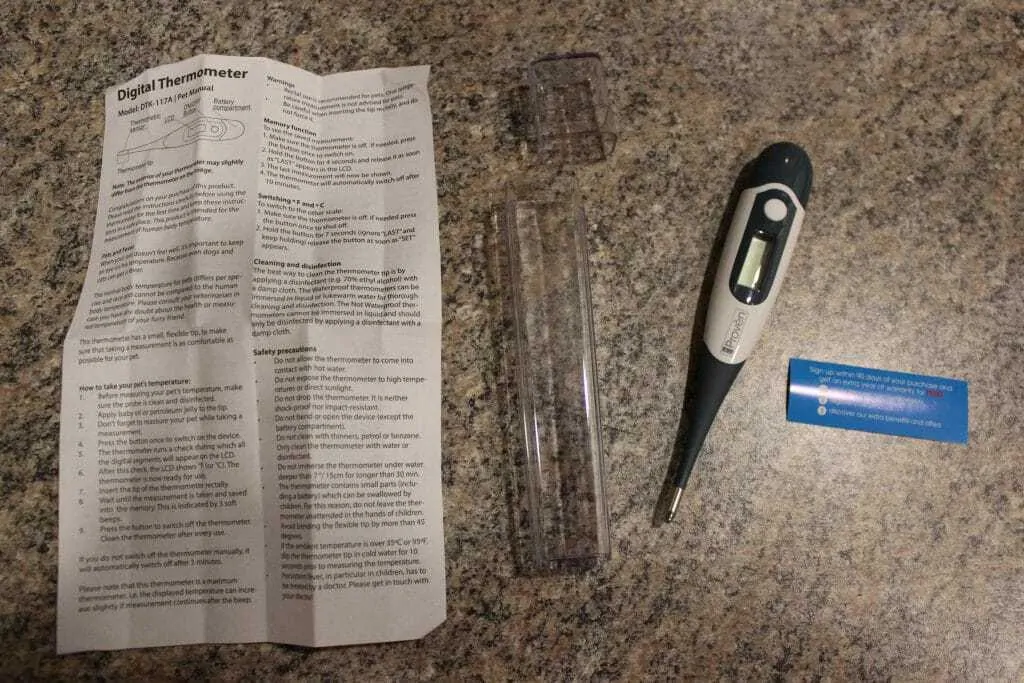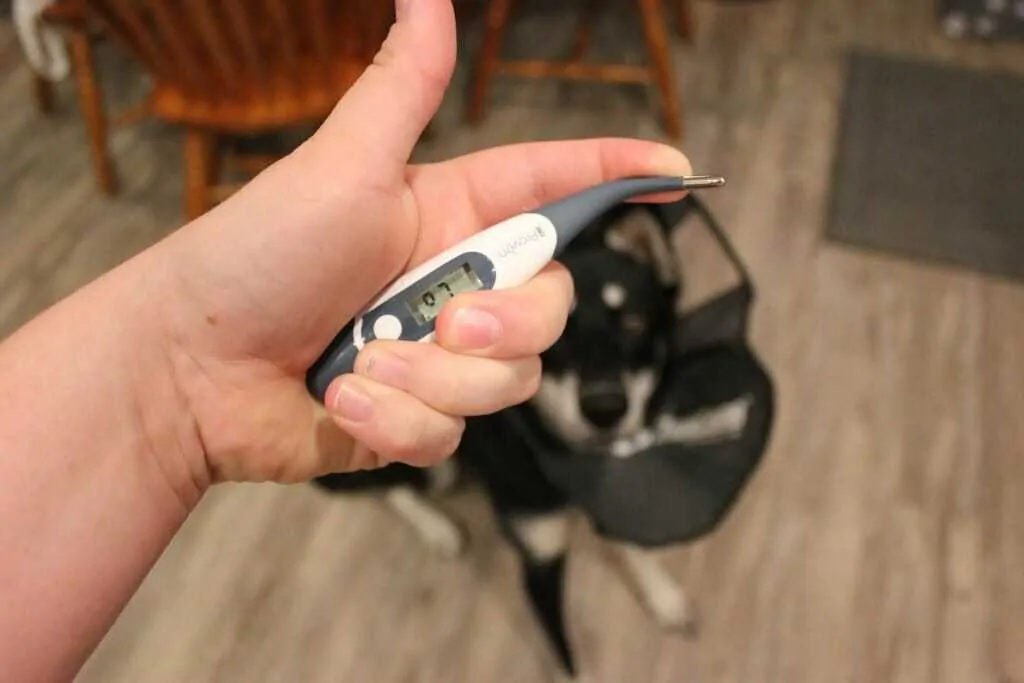One of the first things new parents purchase before they have a baby is a thermometer. Parents know that in the first three months of a baby’s life, any hint of fever can be a huge problem. If their little one happens to feel too warm one evening, they can quickly read the baby’s temperature and know whether to head in to the emergency room or not. Even once the baby is out of the fragile 0-3 months range and is a rambunctious healthy three-year-old, like my son, it’s important to keep a working thermometer on hand. One day a few weeks ago my son felt extra hot. I took his temperature; a whopping 103 degrees! This warranted a call to the doctor, some motrin, and a careful eye on him throughout the night. Even though dogs have different immune systems than people, it’s still important to keep an eye on their health.
I remember a terrifying day many years ago, when my German shepherd, Bella, was just a puppy. Three of the seven puppies remained at home with us: Bella, Scarlett, and Osita. They were about four months old when one afternoon they suddenly all three became lethargic. Bella, who usually hated being picked up, let me pick her up and just hung there in my arms, limp. Her eyes struggled to stay open. The other dogs were the same. I wanted to feel their furry foreheads for fever, but they weren’t human, of course, and that told me nothing. I begged my dad to take them to the animal hospital because it was the weekend and our vet wasn’t open.
He said they’d be fine, they just had a cold or something. If they were worse the next day, we’d take them in. He didn’t want to risk a huge vet bill for nothing. “But what if they die?” I said. He didn’t have an answer for a moment. “They probably just have a bad cold,” he said. “They’ll be fine.”
But all night, I kept getting up and checking on the three puppies in the laundry room. Their mama, Clancy, didn’t seem affected. I made sure they had plenty of water. They didn’t touch their food.
In that moment, it would’ve been really nice to know the following facts about canine temperature, or fever, which is known in medical terms as pyrexia:
- The normal temperature range for a dog is between 99.5 degrees Fahrenheit and 102.5 degrees Fahrenheit. A temperature that’s higher than that, usually at least 103.5, can be considered pyrexia.
- If the fever stays around 103.5 or a little higher and lasts only a day or so, it’s probably nothing to worry about — it’s a sign that your dog’s body is fighting off an infection. In this case, give your vet a call as soon as possible to talk about how best to care for your dog. This might include a quick checkup at the vet’s, even if the fever has passed, to make sure everything’s okay with your pup.
- On the other hand, if the fever remains elevated, gets much higher, or appears more than four times within two weeks, seek veterinary care immediately. If your dog’s temp approaches 105 degrees, get worried. When it reaches 106, lasting damage can happen in your dog.
- There are several symptoms to watch for: lessened appetite, shaking or shivering, weakness, increased breathing speed. But the most obvious symptom of pyrexia is a temperature of 103.5 or higher. The only way to know your dog’s temperature is to take their temperature with a rectal thermometer. NOT a human ear, oral, or forehead thermometer but a rectal thermometer designed for dog use. This is very important.
So what are the reasons for pyrexia? It could be something small and quickly-passing, such as an infection. Or it could point to something more serious, such as a tumor, endocrine or metabolic disease, or even a more serious infection or blockage that requires surgery to remove.
I wish I had had a rectal thermometer that day with Bella, Osita, and Scarlett. It’s likely I would’ve found that their fevers weren’t high — they seemed more alert the next day and by evening were eating again, and after that there were no more problems. But it would’ve been nice to be sure.
It’s important to purchase the correct type of thermometer for your dog.
We recommend every dog owner keep a dog thermometer in their medicine cupboard in case they feel it’s necessary to take their dog’s temperature. Recently, I was concerned about Eira because she just had surgery. I needed to carefully monitor her to make sure she didn’t contract a fever — a sign of infection would be bad right after an invasive procedure like surgery. So after doing some research, I bought and tested a rectal dog thermometer to make sure Eira was healing well.
Find out the results of our test — and which thermometer we ultimately chose — below.
Pavia Fast Rectal Thermometer for Dogs
If you have an elderly dog with known issues with pyrexia due to underlying or unknown causes and you’ve been told to keep careful tabs on her temperature, it’s worth investing in a high-quality, fast-working dog thermometer. This thermometer is on the more expensive side, but again: if you have an aging dog, multiple dogs, special needs dogs, or at-risk rescue dogs, it’s worth the money. Especially because the temperature reads in only 6 seconds. Compare that to other thermometers, which require you to hold the thermometer tip in the rectum for much longer before an accurate reading pops up on the screen.
Do you live with lots of different types of animals in addition to dogs? A bonus of this thermometer is that you can use it on dogs, horses, cats, cows, sheep — basically any domesticated animal. It’s a wonderful tool to keep around to ensure your pets’ health. The Pavia Fast Rectal Thermometer for Dogs reads in Fahrenheit or Centigrade and is accurate to +/- 0.2 degrees. It reads temps as low as 89.6 degrees Fahrenheit to 107.6 degrees Fahrenheit, neither of which you want your dogs ever to reach. Any temperature below 99.5 degrees Fahrenheit is a sign of hypothermia. If left untreated, hypothermia can result in irregular heart activity, and even coma or death. If your dog presents a temperature below 99.5, please see your vet right away — it could be because of cold weather, but the cause could also be more serious: hypoglycemia, heart disease, or sedatives in your dog’s system among the possible causes.
Again, very young and very old dogs are more at risk, so keep a careful eye on symptoms, such as temperature, to ensure your dog’s good health.
No products found.
iProven Pet Thermometer
The biggest plus of this thermometer is that it’s more affordable than the Pavia. It’s the one I picked out for Eira, and I’m impressed with the results. The biggest difference, I think, is that this thermometer takes 20 seconds to get an accurate reading — which is still better than others on the market that read in 60 or even 90 seconds. Imagine making your dog sit still with a foreign object in their rectum for that long!
No matter how you slice it, taking your dog’s thermometer is an invasive procedure and you should proceed with utmost empathy and care. First, make sure you read the instructions of this or any thermometer you purchase.
First, lay out the instructions, read them carefully, and make sure you have all the parts and pieces that should come with your thermometer.
If you scan the instructions in the photo above, you might notice two more things I love about the iProven rectal dog thermometer:
- Unlike the Pavia, It’s waterproof! This is important if you have a really sick dog who can’t hold their bowels (and of course if that’s the case, to the vet you should immediately go), or if you find yourself needing to take a temperature in the rain, or if your dog curiously licks the thermometer before (or after, yuck!) you use it.
- The tip of this thermometer bends for the maximum possible comfort for your dog. It’s already an insult to them to get a metal thermometer inserted into the rectum. I love the iProven has made the job just slightly less horrible for both the human and the sweet dog involved.
Proof of the iProven thermometer’s flexibility. Meanwhile Eira looks on, deeply suspicious of this new contraption I’m about to use on her.
A careful reading of the usage instructions for this thermometer reveal five important steps:
- Press the white button to turn the thermometer on.
- Apply a little bit of lubricant, such as petroleum jelly or baby oil, to the tip of the thermometer. The more comfortable for your dog, the better.
- GENTLY insert the tip of the thermometer into your dog’s rectum. DO NOT FORCE IT.
- Try to keep your pet still and wait 10-20 seconds for the thermometer to beep three times, indicating that it has completed the reading.
- Read the temperature QUICKLY. Okay, that’s not on the instructions but it’s important, as you’ll find out in a moment.
So how did it go with Eira? Here’s how. First, I applied some petroleum (Aquaphor) onto the tip of the thermometer.
A small amount will do just fine.
Next, I gave Eira extra pets and told her what I was going to do. I’m not sure if she understood me, but she relaxed into the petting. If you have a Nylabone or Benebone nearby, this might be a good time to offer it to your dog as a distraction.
I thought I would really hate/be grossed out by the insertion of the rectal thermometer. But it wasn’t that big of a deal. Eira didn’t squirm. Honestly, she seemed to barely notice what I was doing.
In goes the thermometer tip.
And then, the thermometer beeped after just 10 seconds. What a relief! I drew it out and glanced at it — it read 101.5, a perfect temperature. But that temperature faded almost as quickly as it appeared. It’s best to read the thermometer while it’s still in your dog’s body and BEFORE you take it out, because once it hits cold air, this thermometer adjusts accordingly.
Umm, yeah. That isn’t Eira’s real temp! The second I pulled it out of her rectum, it read 101.5, which is normal. It quickly decreased to 95 and then, by the time I snapped a photo, 92.7. This would mean Eira had hypothermia! So be quick to read the thermometer, or read it just before you pull it out of your dog’s body.
After the whole deal was done, I wrapped the thermometer in a tissue to clean with alcohol later and focused on giving Eira plenty of praise and treats.
Eira happily takes a tasty treat.
She did an amazing job getting her temperature taken, and I was relieved to find that there was nothing wrong with her: no fever, nothing. If she starts to present any symptoms of fever, such as loss of appetite or shivering, in the next couple of days, I’ll re-take her temp. And now it’ll be easy since we did it once before!
I doubt I’ll have to use it again for a while, though. But I’m so glad to have it on hand in case I do.
No products found.
It’s important to keep careful tabs on your dog’s health. There aren’t tons of thermometer options on the market, but these two come well-recommended and well-rated and fit just about any budget. Please consider adding a dog thermometer to your stash of medical dog supplies. You never know when you might need it.

Jen Jones is a professional dog trainer and behavior specialist with more than 25 years of experience. As the founder of ‘Your Dog Advisor’ and the ‘Canine Connection’ rehabilitation center, she applies a holistic, empathetic approach, aiming to address root causes rather than merely treating symptoms.
Well known for her intuitive and compassionate approach, Jen adopts scientifically-proven, reward-based methods, encouraging positive reinforcement over punishment. Jen specializes in obedience training, behavior modification, and puppy socialization. Her innovative methods, particularly in addressing anxiety and aggression issues, have been widely recognized. Jen has worked with many of the world’s leading dog behaviorists and in her free time volunteers with local animal shelters and rescue groups.







